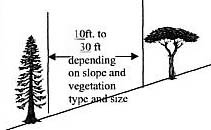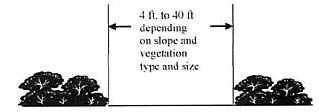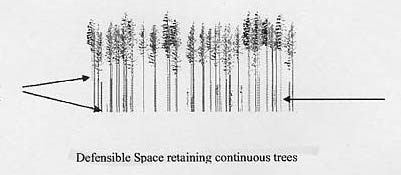
Yosemite West Property &
Homeowners, Inc.
|
Defensible Space: Compliance with 100-foot Requirements
100 Feet of Defensible Space is the Law
New Law Effective 2006
Download a Printer Friendly Version
Draft Guidelines for meeting the Intent of the California Resource Code (PRC) 4291 (a) and (b) and with the California regulation 14, California Code of Regulations (CCR) 1299, Defensible Space
"Recent changes to PRC 4291 expand the defensible space clearance requirement maintained around buildings and structures from 30 feet to a distance of 100 feet."
The intent of the new [for 2006] defensible space regulations is to provide a fuel break that will reduce fire intensity, inhibit fire in crowns (tree tops), reduce the rate of fire spread, and provide a safer environment for firefighters to suppress wildfire.
General Guidelines
- Property owners' clearing responsibility has been extended from 30 feet to 100 feet. It is limited to 100 feet away from their building or to the property line, whichever is less and limited to their land. The newly created zone between 30 feet and 100 feet is called the Reduced Fuel Zone. Property owners are required by law to comply with these new defensible space regulations.
- Adjacent property owners are not required to clear beyond 100 feet from their structure, but are encouraged to do so to create community-wide defensible space.
- Vegetation removal can also cause soil disturbance, soil erosion, re-growth of new vegetation and introduction of non-native, invasive plants. Always keep soil disturbance to a minimum, especially on steep slopes.
- Use safe methods. Internal combustion engines must have spark arresters. Metal blades on cutting equipment can cause sparks when striking rocks. Complete with this equipment prior to periods of high fire danger.
- Although the PRC 4291 regulations do not address woodpiles, they should be moved to 30 feet from structures and protected from wind-driven embers by secure tarps or other means.
- Maintain a firebreak by removing and clearing away all flammable vegetation and other combustible growth within 30 feet of each building or structure. (These are the same requirements that we have been going by for years now.)
- Remove and clear away combustible vegetation. This does not apply to single specimens of trees, ornamental shubbery, or similar plants that are used as ground cover, if they do not form a means of rapidly transmitting fire from the native growth to any building or structure.
- Basically, remove all dead and dying woody surface fuels and aerial fuels within this zone. You don't want to have any vegetation to form a "ladder" for fire to burn from the surface into taller vegetation. This guideline is primarily intended to eliminate trees, bushes, shrubs and surface debris that are completely dead or with substantial amounts of dry or dead branches or leaves/needles that would readily burn.
- Remove loose surface litter, normally consisting of fallen leaves or needles, twigs, bark, cones, and small branches.
- Cut grass to a height of 3 inches within 30 feet adjacent to structures.
- Think about the condition of vegetation throughout the fire season. Remember that if it can dry during the fire season, cut and remove it before it dries.
- Keep grass and other vegetation remaining in this zone green by watering. If watering is not feasible, a vegetation-free space between the dry grass and combustible structure should be provided.
- Remove any portion of a tree that extends within 10 feet of the outlet of any chimney or stovepipe.
- Maintain any tree adjacent to or overhanging any building free of dead or dying wood.
- Maintain the roof of any structure free of leaves, needles, or other dead vegetative growth.
- Provide and maintain at all times a screen over the outlet of every chimney or stovepipe that is attached to any fireplace, stove, or other device that burns any solid or liquid fuel. The screen shall be constructed of nonflammable material with opening of not more than one-half inch in size.
Guidelines for the 30-foot to 100-foot Reduced Fuel Zone
The California Board of Forestry and Fire Protection Guidelines are described below. Visit their website for further information.
- Remove dead and dying woody surfaces and aerial fuels. Loose surface litter, normally consisting of fallen leaves or needles, twigs, bark, cones, and small branches are permitted to a depth of 3 inches in height. This guideline is primarily intended to eliminate trees, bushes, shrubs and surface debris that are completely dead or with substantial amounts of dead branches or leaves/needles that would readily burn.
- Downed logs or stumps, when embedded in the soil, may be retained when isolated from other vegetation.
- Implement one of the following two fuel treatments (options A or B) required by CCR 1299 and PRC 4291.
Properties with greater fire hazards will require greater clearing treatments. Combinations of the methods may be acceptable under § 1299(c) as long as the intent of these guidelines is met.
1. Grass should not exceed 4 inches in height. Maintain grass and other forbs, less than 18 inches in height above the ground when they are isolated from other fuels or where it's necessary to stabilize the soil and prevent erosion. (The exception to the 4-inch height is generally intended for slopes with unstable soil.)
2. Horizontal Clearance Requirements
| Slope |
Trees |
Shrubs |
| 0-20% |
10 feet |
2x height of shrub (eg, 3ft shrub = 6ft spacing) |
| 20-40% |
20 feet |
4x height of shrub |
| › 40% |
30 feet |
6x height of shrub |
| Minimum Horizontal Clearance |
|
from edge of one canopy to edge of next |
between the edges of shrubs |
|
 |
 |
3. Vertical Clearance Requirements
The minimum vertical space between the top of a shrub and the bottom of the lowest tree branches is 3x the height of the shrub (eg, 3ft shrub = 9 ft vertical space between the top of the shrub and the lowest tree limbs).

A vegetation removal option is available for those wanting to retain a continuous stand of larger trees with no space between tree canopies while creating defensible space. Spacing between aerial fuels is not required in a stand of larger trees. In this situation:
- Remove all surface fuels greater than 4 inches in height.
- Remove lower limbs of trees (prune) to at least 6 feet up to 15 feet (or the lower 1/2 branches of smaller trees).
Properties with greater fire hazards, such as steeper slopes or more severe fire danger, will require pruning heights in the upper end of this range.

Additional Standards for Tree and Shrub Removal Recommended by Yosemite Fire Management
Information on healthy tree limbing and removal procedures can be obtained from the Yosemite National Park Forester.
- Remove dead or dying trees and shrubs within the 0ft to 30ft Hazard Clearance Zone.
- Remove trees 6 inches at diameter (measured 5ft from base), see exceptions below:
- Preserve hardwood trees (eg, big-leaf maple, dogwood, cottonwood, birch, willow, and oak)
- When considering conifers, the priority for removal should be incense cedar and white fir, followed by ponderosa pine or Jeffrey pine, and least priority sugar pine.
- Trees with cultural significance or obvious wildlife occupation (eg, cavities or bird nests) should not be removed without guidance.
- No more than 1-3 per acre dead and downed trees less than 15 inches in diameter should be left in the 30ft to 100ft Reduced Fuel Zone.
The Cal Fire (formerly CDF) arranges with USFS fire prevention officers from Sierra National Forest to conduct an Annual Fire Hazard Clearance Inspection in Yosemite West to evaluate property owners' compliance with California Code of Regulations (CCR) 1299 and PRC 4291.
Visit the Cal Fire website for resources on the 100-foot defensible space law. Scroll to the bottom of the page to download the following items:
- Why 100 Feet (1.9MB Flash movie)
- 100 foot Defensible Space (1.4MB Flash movie)
- Defensible Space Zone Song (600KB MP3)
- Make Your Home FIRE SAFE - Why 100 Feet? Factsheet (734KB PDF)
- Why 100 Feet? Brochure (942KB PDF)
Related Documents
NPS Contacts
This information was compiled with support from Don Coffman, former Yosemite Fire Prevention Officer, and Mike Beasley, Fire Use Manager, email: michael_beasley@nps.gov.
Site Map
Copyright text © Yosemite West Property & Homeowners, Inc. 2003-2012,
Copyright photographs © John Mock 2004-2012.
All rights reserved. Unauthorized redistribution of this document is prohibited. Updated February 7, 2012.
|






